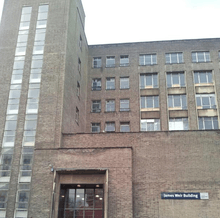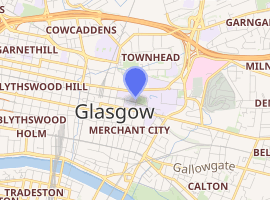James Weir Building
The James Weir Building is an academic building in Glasgow City Centre, Scotland, United Kingdom and is part of the University of Strathclyde’s John Anderson Campus, situated between the Townhead and Merchant City districts of the area. It was completed in 1958 as an extension to the Royal College Building. It is the third largest building on the John Anderson Campus in terms of overall floor area after the Royal College and the Curran Building. In addition, the stair and lift tower on the south east corner of the building is the second highest structure on the campus after the Livingstone Tower, and is highly visible throughout the eastern side of the city centre.
James Weir Building
 Main Entrance  Main Foyer | |
|---|---|

| |
| Former names | The Mechanical Engineering Building |
| General information | |
| Status | Complete |
| Location | Glasgow, Scotland |
| Coordinates | 55°51′43″N 4°14′43″W |
| Current tenants | University of Strathclyde |
| Completed | Phase 1: 1958 Phase 2: 1963 |
| Renovated | 2004-2014 |
| Owner | Glasgow City Council |
| Design and construction | |
| Architect | Wylie, Shanks & Underwood[1] |
The building is home to three faculties, The Department of Chemical and Process Engineering, The Department of Design, Manufacture & Engineering Management and The Department of Mechanical & Aerospace Engineering, all of which are part of the Faculty of Engineering.[2] The James Weir Building is situated on Montrose Street, and is surrounded by the Royal College of Science and Technology building, the Students' Union and the Thomas Graham Building. It is a 5-minute walk from Queen Street railway station and George Square.
Namesake
The James Weir Building is named after a graduate and founder of the Weir Pumps.[3] It was built in two stages in 1957-58 and in 1961-64, this is made obvious by the different coloured bricks at the join of the two buildings. Although it is where some of the university's engineering departments are based, it is probably more recognisable from the Scottish crime dramas Taggart and Sea of Souls produced by STV and BBC Scotland, respectively.[4]
James Weir Fire
At 7:16pm on Tuesday 7 February 2012 a fire broke out in the James Weir building of Strathclyde University, and is believed to have started on the third floor of the building.[5] All of the buildings neighbouring the James Weir building were evacuated including the Strathclyde University’s Student Union where almost 150 students were evacuated as a precautionary measure. Montrose Street was closed to all traffic between Cathedral Street and George Street. It took four fire engines and eight pumps to calm the blaze.[6] The fire took place in the chemical engineering department and was complicated by the presence of hazardous materials. Strathclyde Fire and Rescue Service were able to extinguish the fire by 23:40 and it was reported that no one was injured.[7]
Aftermath of the fire
After the fire some classes have been forced to relocate to nearby buildings including the International Christian College (now demolished) and Vertigo in the Student Union. Some classes even had to be held in the local multiplex cinema. However few classes will be held here, as it is going to cost £44,482 for around 23 hours of teaching.[8] This cost includes costs of temporary lighting being installed, the cinema was hired as without the James Weir building the university did not have anywhere else that could accommodate 650+ students at once. The decision to hire the venue was made as opposed to splitting the students up into several smaller rooms as the university felt it would provide the students with the best learning experience. It is only postgraduate students that will be using the multiplex as replacement. The damage to the James Weir Building will cost around £28 million to repair (however this figure also includes renovations to various buildings across the university campus). The main replacement building is the University of Strathclyde Students' Association (USSA).[9] There have been no reported injuries from the fire, and repairs are expected to be finished in early 2013.[10]
History
The James Weir building was built in 1957-64 and was originally a NE extension to the Royal College Building, which allowed the expanded Royal College to attain the royal charter and become the University of Strathclyde.[11][12] The building was originally named The Mechanical Engineering Building as an extension to the Royal College Building, but later renamed to the James Weir Building after one of the founders of G. & J. Weir Ltd, later known as the Weir Group.[13] In the BBC Scotland drama Sea of Souls, the James Weir Building was used to shoot the fictitious "Murray Thompson Building" and was used extensively throughout the program.
To build the extension (now known as the James Weir Building) to the Royal Technical College, significant amounts of funding had to be raised. The college (before it became known as the University of Strathclyde) sent out documents that a beneficiary could sign, in the process stating how much funding they would put forward to the project. The extension was needed to lessen the strain on the college as it was becoming increasingly overcrowded due to an influx of students, 3800 students attending before World War II increased to 6000 after the war.
The building was planned to contain engineering laboratories in the basement and ground floor, with lecture rooms, other laboratories and administrative offices on the floor above. The Civil and Mechanical Engineering Department was moved from the college to the extension, this helped free up space in the main college building.
The original estimated cost of the complete building was £750,000. Governors wished to proceed quickly with the first stage of development which was estimated to cost £445,000, towards which Government grants amounting to £334,000 had already been advised. The Governors of the college would have to raise £350,000 on their own initiative to complete, equip the building and to provide a moderate endowment for research. The Governors launched their appeal to their public and private supporters.[14] The response to the appeal for funding rose just over £360,000.[15] The building was constructed in two distinct phases; the southern two thirds of the structure opened in 1958; the remaining third was constructed in the early 1960s in tandem with the adjacent Thomas Graham (Chemistry) building in 1962 - the join between the two sections of the structure is still highly visible over 50 years later.
A further extension in 1976 was built, which extended the thermodynamics laboratory, onto which an extension block to the Students' Union Building was also added. Redevelopment plans have been proposed which would convert the laboratory into a walkthrough atrium which would open a direct pedestrian route between Montrose Street and John Street (on old maps of Glasgow this was in fact a continuation of Martha Street) - a link that was severed when the building was constructed in the late 1950s.
Inside the Building
Before the fire
The letter M, for Montrose Street Block, followed by a corresponding hundred number (even for the west facing rooms and odd for the east facing rooms) is used for the room numbering. The building consists of 7 floors, a ground floor to a sixth floor, that are occupied with many laboratories, lecture rooms and on the upper floors there are several offices.[16]
- Sixth Floor: Main offices for the Department of Mechanical Engineering. Twenty small staff rooms and seven central offices.
- Fifth Floor: Main offices for the Department of Design, Manufacture and Engineering Management. Eight drawing and design offices with drawing staff and model store rooms.
- Fourth Floor: Eight lecture rooms, one (M406) specially fitted for more general lectures and society meetings.
- Third Floor: Mining Engineering Department
- Second Floor: Fourteen rooms used as lecture rooms, laboratories and research rooms.
- First Floor: Eight laboratories, three junior and five senior. Link to Level 6 of the Royal College Building.
- Mezzanine Floor Several of the ground floor laboratories have mezzanines housing offices, and a further mezzanine exists on the south staircase to access Level 5 of the Royal College Building.
- Ground Floor: Eight laboratories. Link to Level 4 of the Royal College Building.
- Basement: Building Services, and link corridor to Level 3 of the Royal College Building.
Restoration and Development
In 2000, the lecture floor on Level 4 received a comprehensive redevelopment which saw the first of the University's Interactive Teaching Clusters built. All lecture rooms were completely rebuilt with new lighting and modern projection equipment. Between 2004 and the present, the James Weir Building has had a recent major refurbishment (worth over a million pounds) on levels 1 and 2.[17] Six of the ground floor laboratories were redeveloped, with the removal of obsolete machinery and equipment allowing extra mezzanine space to be constructed within. At the same time the building was upgraded to modern fire regulations, with additional fire doors installed in corridors and staircases.
The top priority for the Faculty of Engineering is to accommodate Civil Engineering and Architecture in the James Weir Building, thus allowing the Colville and Architecture Buildings be redeveloped into a central teaching hub - this project took place over much of 2019 with completion due for 2020.
However the James Weir Building will not always be the centre of Engineering, as "“The new technology and innovation centre and the Engineering and Physical Sciences Quarter in the west of the campus are interdependent and is anticipated that staff from some areas of Engineering and Physical Sciences will move into the new centre."[18]
References
- Williamson, Riches and Higgs, E, A and M (1990) Glasgow, The Buildings of Scotland Series London
- . University of Strathclyde Glasgow Website, "James Weir Building"
- Weir Group, "Wikipedia article"
- Namesake, "Strathclyde University Website" Archived 1 March 2012 at the Wayback Machine, 2012
- Alan Robertson, "University evacuated after major blaze", The Journal, 08/02/2012
- Gavin Stuart, "Strathclyde students evacuated after fire", STV Glasgow, 07/02/2012
- Rich Preston, "Investigation into major fire at Strathclyde University", BBC News Glasgow & West Scotland, 08/02/2012
- Gareth Llewellyn, "Cinema trips cost Strathclyde £45k", The Journal, 24/10/2012
- Gareth Llewellyn, "Further disruption for Strathclyde teaching students", The Journal, 12/09/2012
- Silja Slepnjov, "James Weir Building Damaged by Fire", Strathclyde Telegraph, 07/02/2012
- Royal Commission on the Ancient and Historical Monuments of Scotland, "James Weir Building"
- University of Strathclyde Glasgow Website, "History" Archived 28 January 2012 at the Wayback Machine
- Extract from the court minutes of University of Strathclyde 1968 (ref: GB 249 OS/3/1/4), "Strathclyde Archives", University of Strathclyde Archives
- Royal Technical College Glasgow College Extension 1950 (ref: E/7/3/3), "Strathclyde Archives", University of Strathclyde Archives
- The Royal College of Science and Technology Glasgow: Mechanical, Civil, Chemical and Mining Engineering Block (ref: E/7/3/10), "Strathclyde Archives", University of Strathclyde Archives
- The Royal College of Science and Technology Glasgow - Mechanical, Civil, Chemical and Mining Engineering Block, Strathclyde Archives, Archive reference OE/7/3/10
- Taylor and Fraser Construction Division, "University of Strathclyde, James Weir Building, Phase 4, Levels 1 and 2"
- Strathclyde Estate Strategy, [(http://www.strath.ac.uk/estates/information/estatestrategy/ "University of Strathclyde website"]